Greek Folk Instrument Groups
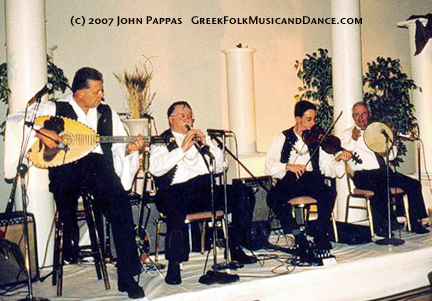
Lavouto, klarino, violi, defi: A typical mainland Greek ensemble.
The following are common instrumentation groups found in Greek folk music. Click on the jump links below to learn more about the various groups. To see pictures of the various instruments, click on the instrument name links within each category.
In each folkloric area of Greece the musicians play different folk instruments. Some instruments are found in many areas, while some are only found in a few regions. The typical folk orchestra of the mainland includes the klarino (Greek Albert system clarinet), the violi (violin), the lavouto (Greek lute), the defi (Greek hand drum like the tambourine), and sometimes the sandouri (a Greek hammered dulcimer). The typical island folk orchestra usually includes the violi and the lavouto, and sometimes the santouri. In Thrace and some of the Aegean islands they often include the toumbeleki, a hand drum.
In traditional Greek folk music the musicians do not play harmony but instead use heterophony. Each musician plays the melody in a different way (improvising decorations and embellishments). Sometimes at the end of a song, the lead musician will play improvisations (taximia) in the mode of the song, and this excites the dancers to new heights.
Mainland Instrument Groupings
Typical Mainland Greek "Koumbania": Klarino, Violi (Violin), and Lavouto
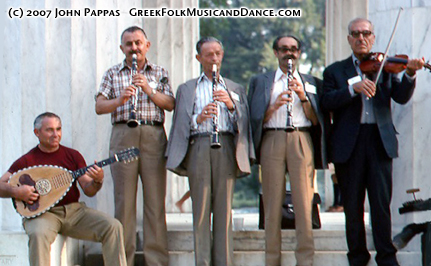
Lavouto, klarina (Hristos and Nikos Adamopoulos), and violi (Aleko Ikonomopoulos): A typical mainland instrument grouping. Smithsonian Bicentennial Folklife, 1976.
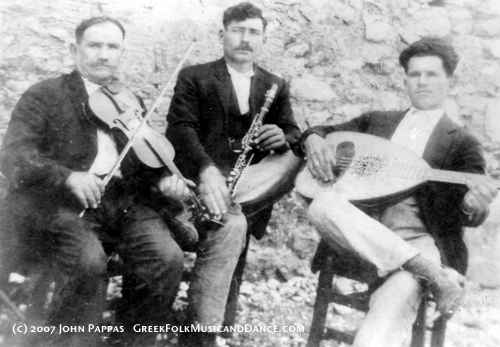
An older mainland orchestra: Kandyla musician in Lafka, c. 1930s.
The klarino is the Greek clarinet, and it is the most popular lead melody instrument in the mainland regions of Greece. It is an Albert system clarinet which is an older, more primitive version of the clarinet now common in classical and popular music in most of Europe and America. The Albert system klarino has fewer keys and has a different tone than the modern clarinet. The Greek "klaritzides" also play the klarino with a different style and sound than that used by classical musicians in Europe and America. The klarino in the key of "C" ("do") is a favorite of the old folk klaritzides.
The violi is the typical violin that most people are familiar with, but the Greek "violitzides" usually play it with a distinct Greek style, depending on the region of Greece. Sometimes different tunings are used by the Greek folk "violitzides."
The lavouto (lagouto, laouto) is a Greek lute. It has four pairs of metal strings tuned do, sol, re, la (C, G, D, A). It is the main accompaniment instrument for music on the Greek mainland and on the islands. The "lavoutieris" plays chords and a rhythmic accompaniment for the melody instruments of the group. On the mainland the lead instrument would be the klarino (along with a violi and perhaps a santouri). On the islands, the lead instrument would be a violi (or on some islands such as Crete or Karpathos, the Greek bowed instrument, the lyra). Sometimes the lavouto is used as a melody instrument, especially on the island of Crete.
Mainland (older style): Karamoudza, Daouli
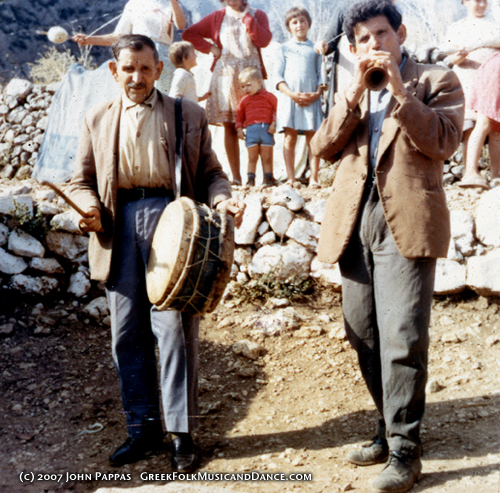
Daouli and karamoudza: Yero-Brilis and Karas (Yiorgis Vardouniotis). Village of Kandyla, 1966.
Before the klarino arrived in Greece (approximately 1830), the main instruments in the mainland of Greece were the double reed Karamoudzes and the Daouli drums. Variations of these instruments could be found in most regions from the north all the way to the south, and even on some of the islands. The Karamoudza is always accompanied by the daouli. This "pair" of instruments was called a "zygia" which comes from the word meaning a pair. Sometimes the Karamoudzes are played in pairs with one of the musicians playing a drone. This creates a similar sound to the drones used in the ancient Byzantine chanting style of the Greek Orthodox Church. Although the klarino, lavouto and violi type of "koumbania" tended to become more popular, in many areas the karamoudza type music has continued to be popular.
The Karamoudza is similar to the ancient Greek Avlos, which was also a double reed instrument. Drawings from ancient Greek vases show that musicians usually used some sort of a "lip guard" which helped them keep their lips from losing air as they played. Today, karamoudza players use the "kareli" or small wooden disk for the same purpose. Other names for the Karamoudza include: pipiza, zournadi, and zournas. They range in size from the small, approximately 5 or 6 inch zournadi to the large approximately 20 inch long zournas common in Greek Makedonia. In Peloponnisos and Roumeli, the pipizes or karamoudzes are usually about 12 inches long.
The Daouli is the two headed drum. The daouli player usually hangs the drum from a belt or strap over his left shoulder. The right side of the drum has a lower pitched skin, while the left side has a higher pitched skin. Goatskins are often used for the drumheads. The right or lower side is struck with the "daouloxylo" or daouli stick, and the left or higher pitched side is struck with the "daouloverga" or daouli switch. The main dance beats are played with the heavier stick on the right side, while the decorative and "in between" beats are played with the light stick. Other names for the daouli, depending on the area, include toumpano, tymbano, or toumbi. This is from the ancient Greek word tympano which exists in English in the word "tympani" for the drum section in the modern classical orchestra, and the tympanic membrane for the ear drum. These drums vary in size from the small 12 to 14 inch diameter toumbi, to the 3 to 4 foot diameter daouli in the north of Greece. The most common size in Peloponnisos and Roumeli tends to be about 20 to 30 inches in diameter.
Thrace (older style): Gaida, Daire
Makedonia (older style): Gaida, Defi or Daouli
Island Instrument Groupings
Islands: Violi, Lavouto, Santouri
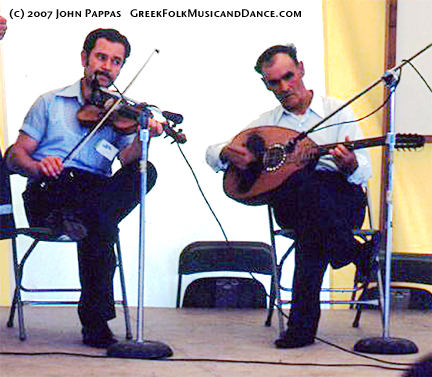
Violi and lavouto from the island of Amourgos.
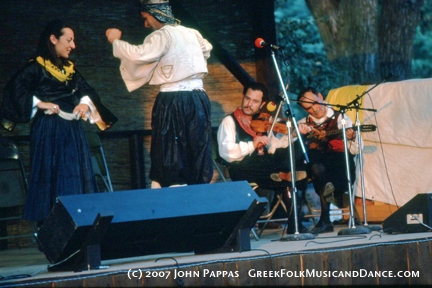
1976: Lavouto and violi play for Skyrian dancers.
Islands (older style): Lyra, Lavouto
Islands (older style): Tsabouna, Toumbi

Tsabouna and toumbi from the Island of Kythnos.

1976: Lavouta and Cretan Lyra.
Crete (older style): Tsabouna, Daouli
Asia Minor
Asia Minor: Violi, Outi, Toumbeleki (Santouri, Kanoni)
Asia Minor (older style): Lyra, Outi, Defi (Santouri, Kanoni)
Other Groupings
Seaport Tavernes; Urban: Bouzouki, Baglamas, Guitar

A relatively typical bouzouki band: Guitar, bouzouki, violi, defi.
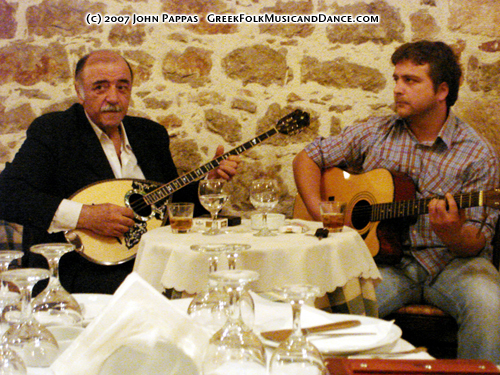
Bouzouki and kithara (guitar), Napflion, 2006.
The bouzouki is the main or lead folk instrument found in the taverna style or rebetiki music of the seaports and urban areas of Greece. The bouzouki is the descendent of ancient Greek and eastern instruments. In ancient times the name of this long-necked string instrument was the "trichordo" or "three stringed instrument." During the Byzantine period, it had many names including "tambouras," "yiongari," "pantouri," and others. It has three pairs of strings tuned re, la, re (D, A, D). In the 1950's, a bouzouki with four pairs of strings tuned to the intervals of the high four strings of the guitar was developed. It is tuned down one key from the guitar's tuning to (C, F, A, D). The bouzouki is the main lead instrument for the rebetiki or taverna orchestra. The make up of the typical musical group has varied and changed over the years and has included many types of instrument groupings. A very common musical group might be one or two bouzoukia, a baglamas, and a kithara (guitar). Sometimes a violin, or an accordion, a piano, or other instruments would be played as well. Similar instruments that are played like the bouzouki in this style of music are the tzouras (long necked, like the bouzouki, but with a smaller body), and the baglamas (a very small bouzouki).
The baglamas was often favored in the early part of the 20th century as a solo instrument for men in jail or for a small group of "rebetes" to play for singing and dancing. It is a smaller version of the bouzouki and is tuned re, la, re (D, A, D), but an octave higher than the bouzouki's tuning. A saying that the old "rebetes" used to quote was: "Eho to baglamadaki, kato ap' to sakaki." "I have my baglamadaki under my coat." This refers to the fact that they would carry the small instrument tucked into the back of their belt, under the back of their coat tail so that it did not show. If they found the occasion to play for their own expression, or for some friends, they could take the baglama out. However, if the situation was not appropriate for a good "kefi" (mood), they could keep it out of sight.
This page was last updated on 10/7/2007.
